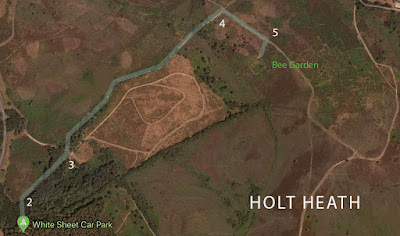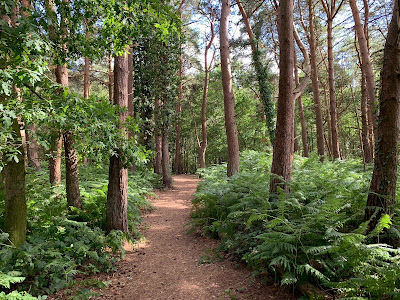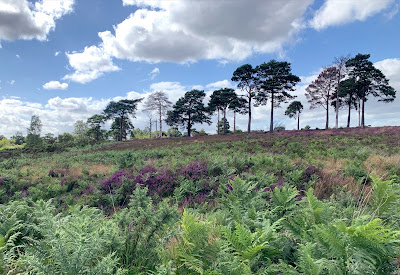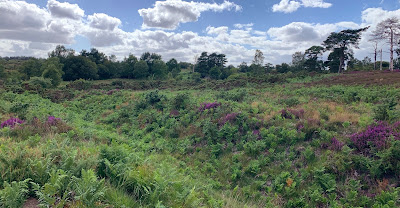 A walk to locate the Bee Garden. An earthwork enclosure on Holt Heath National Nature Reserve.
A walk to locate the Bee Garden. An earthwork enclosure on Holt Heath National Nature Reserve. Holt Heath is a protected National Nature Park North of Wimborne Minster in Dorset.
Bee Garden (50.836802, -1.922901)
Parked at map ref (50.8322705,-1.9350979,509)
Please take a look at the video
 |
| Map Of Bee Garden Walk (Click to enlarge) |
Walking from the car park go through the small gate on the north side of the car park. This will take you a short distance through some woods where you join another track and go right.
Carry on until the woods end and you will find a three way path. Take the left-hand path towards the road And follow it until you reach a crossroads.
Turning right at the crossroads there is a shallow descent down a wide path. Passing a line of Scots pine on the right you come to the entrance of the Bee garden.
Walking diagonally you can find small paths. you will definitely notice the ditch and ramparts. The ramparts is about a metre high and the ditch about the same. From the bottom of the ditch its height is about 2 m or 6 1/2 feet. it’s a steep scramble to the top.
 |
| Artist illustration of a medieval bee garden |
Ramparts are well defined and it looks to be squarish in shape. It’s actually 26.5 x 22.8 metres (29 x 25 yards) in size. There are some really good views of the heath from here. I went in June and the purples and yellows were just starting to come out.
 |
HISTORY
Bee gardens were an important part of heathland life from the Medieval period. The hives had changed little since the Roman occupation. Bell shaped baskets called Skeps were put on small platforms that could be moved throughout the pollen season.
 |
| Artist impression of a heath bee garden |
The main product of the bees work was the honey and beeswax they produced. Honey was used both for food sweetening and also for the many medicinal purposes it can perform. Fermented honey also made Mead a medieval beer.
But beeswax was the most profitable product for the beekeepers. The beeswax was used for the church candles because the tallow candles the commoners used was considered of an impure light and too smelly for services. It was also in demand by the nobility of the times both for lighting and wax seals.
 |
| The Beekeepers, 1567 by Bruegel the Elder |
This area of Holt heath is still known as the Bee garden today and its rectangular shape would certainly keep the worst of the wind and weather from the skeps. But if this was built as a bee garden then the earthwork enclosure built round it at some 2 - 3 metres in height seems like a fortification .
This would be far more practical as an animal enclosure or as a local meeting place similar to a Moot still visible in the area. Is it Bronze Age? Maybe, maybe not and until some excavation or ground work is done the answer is unknown.
ABOUT BRONZE AGE WALKS
Bronze Age Walks with an iPhone are a collection of short, filmed walks with maps defining Bronze Age sites. The emphasis is on Neolithic, Bronze Age and Iron Age because I find them a good lodestone for a walk.
The walks are usually not a great distance so you don’t have to be super fit to do them. In fact Bronze Age Amble would work. They largely stick to recognisable paths but it is probably a good idea to protect your legs a bit as gorse can be fairly prickly and common in places.
Bronze Age Walks
Cannon Hill 3 Bronze Age Barrows
Summerlug barrow and hill - Holt Heath - Wimborne - Dorset
Bronze Age Walks-Bee-Garden-Holt-Heath
Bronze Age Walks The Oldest living inhabitant in Dorset




No comments:
Post a Comment